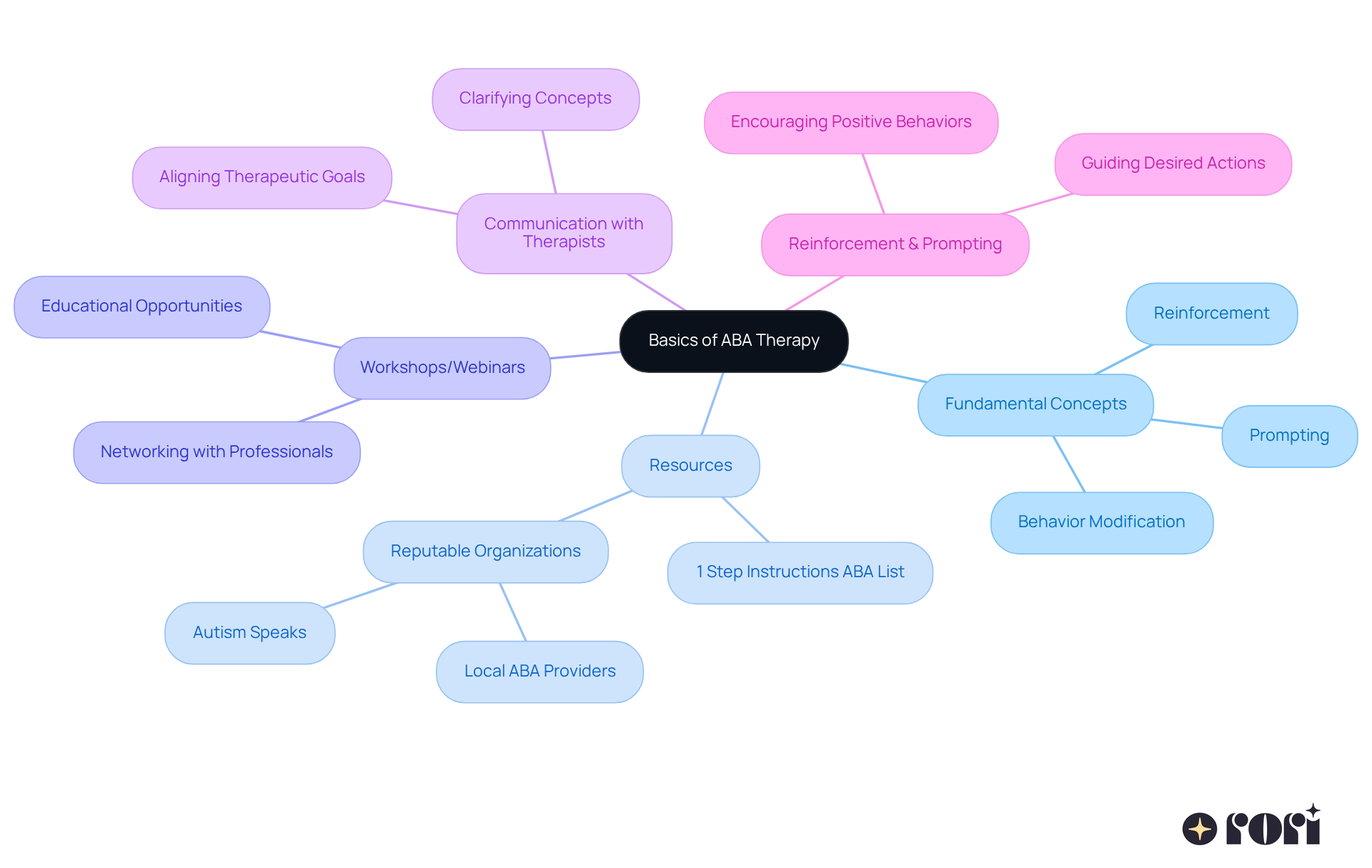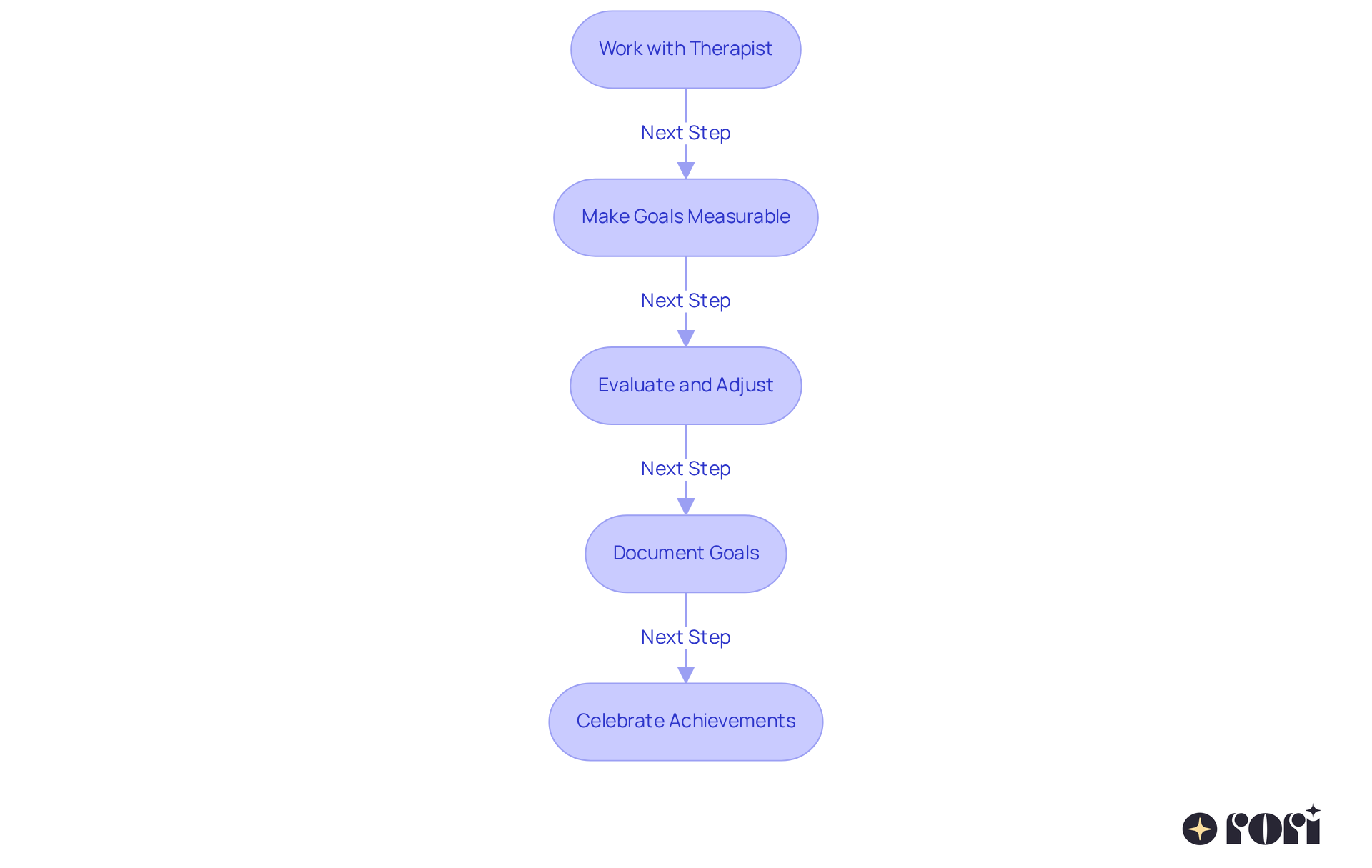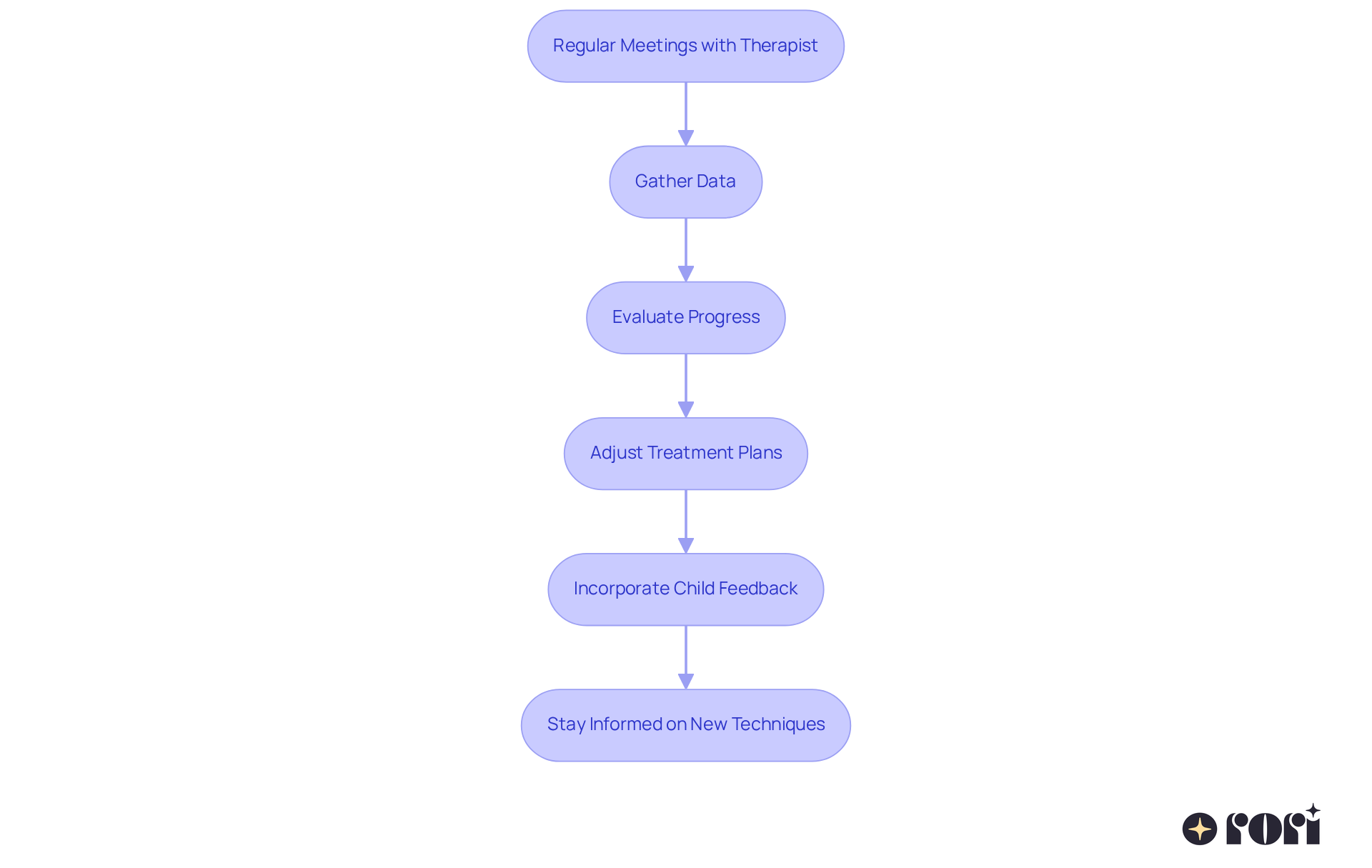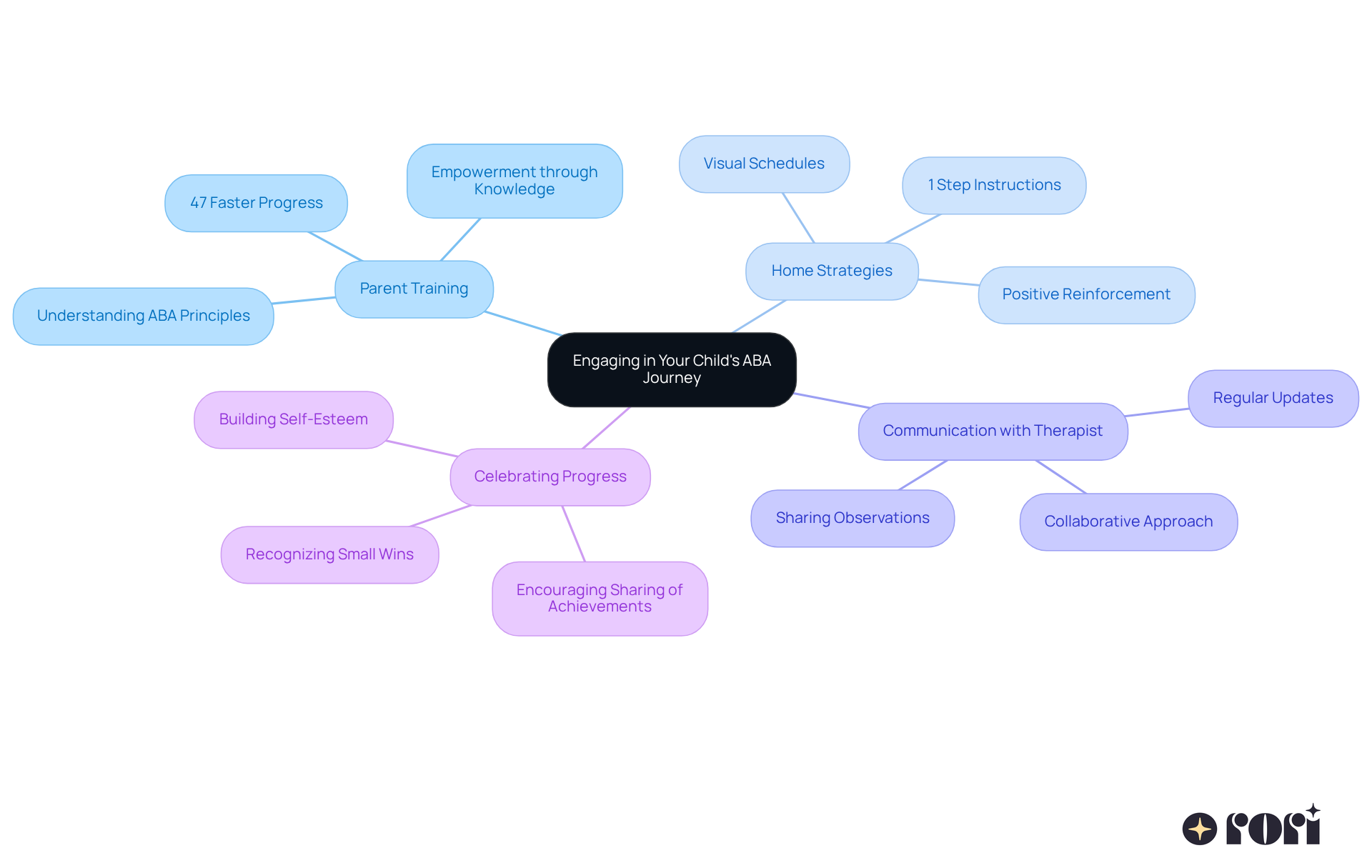This article offers a friendly four-step guide for parents looking to enhance their child's ABA therapy. It starts by helping you understand ABA principles, then moves on to:
Each step highlights the importance of collaborating with therapists, setting measurable objectives, and using consistent reinforcement strategies. Together, these elements can lead to better outcomes for children undergoing ABA therapy.
Let’s explore this together! By understanding these principles, you can feel more connected and involved in your child's journey. Imagine setting clear goals that resonate with your family’s values—how empowering is that? Regular evaluations can help you see progress and adjust strategies as needed, making the process feel more collaborative.
And remember, your active involvement is key! Engaging with the therapy process not only supports your child but also builds a strong partnership with their therapists. We’re here to help you every step of the way, ensuring you feel confident and supported throughout this journey. Let's make this a positive experience for both you and your child!
Navigating the intricacies of Applied Behavior Analysis (ABA) therapy can feel overwhelming for parents on their child's therapeutic journey. But don’t worry! This article is here to offer you a practical four-step guide designed to empower you as a caregiver. We’ll focus on:
Yet, the real challenge lies in turning these strategies into effective daily practices that genuinely resonate with your child's unique needs. How can you bridge the gap between theoretical knowledge and real-world application? Together, we can foster meaningful progress! Let’s explore this journey together!
Start by getting to know some fundamental ABA concepts, like reinforcement, prompting, and behavior modification. Understanding these principles is key to effectively supporting your child's healing journey.
Dive into introductory materials or guides on ABA practices, which include 1 step instructions aba list, to build a solid foundation. Resources from reputable organizations can offer valuable insights into the methodologies and benefits of ABA.
Consider attending workshops or webinars that focus on ABA principles. These sessions not only expand your knowledge but also provide chances to connect with other parents and professionals, sharing experiences and strategies that have worked well in real-life situations.
Don’t hesitate to engage in discussions with your child's therapist to clarify any tricky concepts. Open communication helps ensure that you’re aligned with the therapeutic goals and can reinforce strategies at home.
Make the most of resources from trusted organizations, such as Autism Speaks or local ABA providers, by referring to the 1 step instructions aba list to access additional materials and support networks. These resources can help you stay updated on the latest advancements in ABA practices and offer practical tools for implementation.
Remember, reinforcement and prompting are vital components of ABA therapy! Reinforcement encourages positive behaviors, while prompting guides your child toward desired actions. As ABA professionals often highlight, effectively using these techniques can greatly enhance learning outcomes and behavioral improvements. Let’s explore this together!

Work closely with your child's therapist to create specific objectives tailored to their unique evaluation. This partnership helps ensure that the goals reflect your child's individual strengths and challenges, which is a vital part of the 1 step instructions aba list in Applied Behavior Analysis Therapy. By focusing on adaptive treatment strategies, you can help ensure that your child receives personalized support that evolves alongside their needs.
Make sure all goals are measurable and time-bound, allowing for effective tracking of progress. For example, instead of a vague goal like 'improve communication skills,' specify that your child should 'initiate and maintain a conversation with a peer for three minutes.' This clarity makes it easier to monitor development accurately and aligns with the 1 step instructions aba list used in evidence-based strategies for ABA therapy.
Consistently evaluate and adjust objectives to meet your child's evolving needs. Ongoing conversations with the therapist facilitate timely adjustments, ensuring that the objectives remain relevant and attainable as your child progresses. This continuous assessment is essential for promoting positive behavior changes and skill development, supported by automatic data collection that ensures precise monitoring without interrupting treatment sessions.
Document goals in a visible spot to reinforce them daily. This approach keeps the goals at the forefront of your child's treatment, encouraging consistency across different settings and focus in their learning. Empowering caregivers with ABA principles and strategies enhances support and informed decision-making, contributing to the overall effectiveness of the therapy, which is also covered by insurance.
Celebrate every achievement, big or small, to boost motivation and a sense of accomplishment in your child. Acknowledging progress fosters ongoing involvement and highlights the importance of their efforts, ultimately leading to improved behavioral outcomes. Let’s explore this journey together!

It's important to arrange regular meetings with your child's therapist to check in on their progress and address any concerns. This collaborative approach helps ensure that both parents and therapists are on the same page about your child's development. This shared understanding is crucial for adjusting treatment plans based on the latest updates and your involvement as a caregiver.
Consider using different methods to gather data, including the 1 step instructions ABA list for tracking behavior frequency and employing ABC data collection. These techniques can offer valuable insights during evaluations. Research shows that ongoing data collection is vital for assessing how well interventions are working and for tailoring therapy plans. This way, the therapy stays focused on your child's needs and remains adaptable.
Be open to adjusting goals and methods based on your child's progress and the therapist's feedback. Flexibility in treatment plans can really boost outcomes! Studies indicate that many goals improve after implementing effective treatment models. This adaptability is a key part of early intensive behavioral intervention (EIBI), which aims to enhance learning, verbal, and social skills in individuals with autism.
Encourage your child to express their feelings about the treatment. Their feedback can lead to important changes. Understanding their perspective can create a more supportive environment and boost their motivation, ultimately leading to better behavioral outcomes.
Stay updated on new techniques or strategies that could benefit your child. Ongoing education about developments in ABA therapy can empower you to advocate for effective interventions by following the 1 step instructions ABA list tailored to your child's unique needs. This knowledge enhances your ability to support them and make informed decisions.
Let’s explore this together! We’re here to help you every step of the way!

Join us for parent training sessions at Rori Care - ABA Therapy, where you'll discover effective strategies to support your child's development. Did you know that when parents participate in ABA training, children can progress up to 47% faster than those who only receive clinical intervention? By getting involved, you not only deepen your understanding of ABA principles but also empower yourself to make informed decisions that positively influence your child's growth.
Consider using the 1 step instructions aba list at home, such as implementing visual schedules and positive reinforcement. These methods have been shown to boost children's engagement and learning. In fact, kids in early intervention programs can see a 60% reduction in challenging behaviors within just six months of starting therapy! Your consistent use of these strategies is vital for reinforcing the behaviors and skills you want to see.
Creating a structured daily schedule that includes a 1 step instructions aba list is a fantastic way to provide the consistency your child needs for development. This organized approach not only supports learning but also aligns with the flexible treatment strategies that Rori Care tailors based on your child's needs.
Don't forget to communicate regularly with your child's therapist! Share your observations and seek advice to foster a collaborative approach that can lead to even better outcomes. Continuous communication is key to adapting strategies as your child develops, ensuring that interventions remain tailored to their evolving needs.
Celebrate every bit of progress your child makes, no matter how small! Encourage them to share their achievements with family and friends, which helps reinforce their motivation and self-esteem. With an impressive success rate of 89% for treating autism with ABA therapy, every little step forward is a testament to the effectiveness of these strategies and the important role you play in your child's journey. Let’s explore this together!

Understanding and effectively engaging with ABA therapy can truly enhance your child's therapeutic journey! This article outlines a friendly four-step approach that empowers you as parents to support your child's development through Applied Behavior Analysis. By grasping the core principles of ABA, defining clear goals, conducting regular evaluations, and actively participating in the process, you can create a nurturing environment that fosters growth and progress.
Key insights discussed include:
Regular evaluations and adjustments to treatment plans ensure that the therapy remains tailored to your child's evolving needs, while your involvement can lead to remarkable improvements in progress rates.
Ultimately, the journey through ABA therapy is a collaborative one. By taking an active role and utilizing effective strategies, you can not only enhance your child's learning outcomes but also cultivate a supportive atmosphere that celebrates every achievement. Embrace this opportunity to engage in your child's development, and witness the transformative power of effective ABA practices in action. Let’s explore this together!
What is ABA therapy?
ABA therapy, or Applied Behavior Analysis, is a therapeutic approach that focuses on understanding and modifying behavior through principles such as reinforcement, prompting, and behavior modification.
Why is it important to understand the basics of ABA therapy?
Understanding the basics of ABA therapy is key to effectively supporting a child's healing journey, as it helps caregivers implement strategies that promote positive behaviors and learning outcomes.
What are some fundamental concepts of ABA therapy?
Fundamental concepts of ABA therapy include reinforcement, which encourages positive behaviors, and prompting, which guides a child toward desired actions.
How can parents learn more about ABA practices?
Parents can learn more about ABA practices by diving into introductory materials or guides, attending workshops or webinars, and engaging in discussions with their child's therapist.
Where can I find reliable resources on ABA therapy?
Reliable resources on ABA therapy can be found through reputable organizations such as Autism Speaks or local ABA providers, which offer valuable insights and support networks.
What is the role of reinforcement in ABA therapy?
Reinforcement in ABA therapy encourages positive behaviors by providing rewards or incentives when a desired behavior is exhibited.
How does prompting work in ABA therapy?
Prompting in ABA therapy involves guiding a child toward desired actions, helping them learn how to perform specific tasks or behaviors.
How can parents ensure they are aligned with therapeutic goals?
Parents can ensure alignment with therapeutic goals by maintaining open communication with their child's therapist, discussing any tricky concepts, and reinforcing strategies at home.